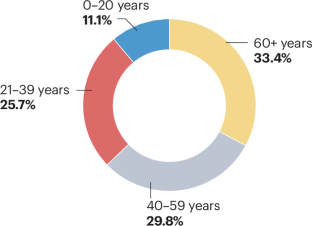老年人 1 型糖尿病的流行病学
IF 31
1区 医学
Q1 ENDOCRINOLOGY & METABOLISM
引用次数: 0
摘要
尽管 1 型糖尿病(T1DM)在传统上被视为一种青年发病的疾病,但被诊断出患有这种疾病的老年人数量却在不断增加。T1DM 患者平均寿命的延长也是导致老年患者人数不断增加的原因之一。我们总结了有关老年人(年龄≥60 岁)T1DM 流行病学(发病率、患病率和超额死亡率)以及遗传学、免疫学和诊断难题的证据。一些研究报告称,T1DM 在老年人中的发病高峰与儿童相似,甚至超过儿童,而且人群发病率通常随着年龄的增长而增加。谷氨酸脱羧酶抗体阳性经常见于成人型 T1DM。老年 T1DM 与 2 型糖尿病的鉴别指南建议测量 C 肽和自身抗体水平,包括谷氨酸脱羧酶抗体。然而,目前还没有区分 60 岁及以上老年人 T1DM 和 2 型糖尿病的金标准。因此,在 T1DM 流行病学中观察到的全球差异可能部分是由于分类错误造成的,而分类错误会随着糖尿病发病年龄的增加而增加。随着全球患有 T1DM 的老年人口不断增加,需要改进遗传学和免疫学证据,以区分老年人的糖尿病类型,从而形成清晰的流行病学图谱。本文章由计算机程序翻译,如有差异,请以英文原文为准。


The epidemiology of type 1 diabetes mellitus in older adults
Although type 1 diabetes mellitus (T1DM) is traditionally viewed as a youth-onset disorder, the number of older adults being diagnosed with this disease is growing. Improvements in the average life expectancy of people with T1DM have also contributed to the growing number of older people living with this disease. We summarize the evidence regarding the epidemiology (incidence, prevalence and excess mortality) of T1DM in older adults (ages ≥60 years) as well as the genetics, immunology and diagnostic challenges. Several studies report an incidence peak of T1DM in older adults of a similar size to or exceeding that in children, and population prevalence generally increases with increasing age. Glutamic acid decarboxylase antibody positivity is frequently observed in adult-onset T1DM. Guidelines for differentiating T1DM from type 2 diabetes mellitus in older adults recommend measuring levels of C-peptide and autoantibodies, including glutamic acid decarboxylase antibodies. However, there is no gold standard for differentiating T1DM from type 2 diabetes mellitus in people aged 60 years and over. As such, the global variation observed in T1DM epidemiology might be in part explained by misclassification, which increases with increasing age of diabetes mellitus onset. With a growing global population of older adults with T1DM, improved genetic and immunological evidence is needed to differentiate diabetes mellitus type at older ages so that a clear epidemiological picture can emerge. This Review discusses the incidence, prevalence and disease burden of type 1 diabetes mellitus in older adults in diverse geographical regions. The challenges involved in defining and diagnosing type 1 diabetes mellitus in this population and the implications of these challenges for epidemiological studies of this disease are also addressed.
求助全文
通过发布文献求助,成功后即可免费获取论文全文。
去求助
来源期刊

Nature Reviews Endocrinology
医学-内分泌学与代谢
CiteScore
42.00
自引率
0.70%
发文量
158
审稿时长
6-12 weeks
期刊介绍:
Nature Reviews Endocrinology aspires to be the foremost platform for reviews and commentaries catering to the scientific communities it serves. The journal aims to publish articles characterized by authority, accessibility, and clarity, enhanced with easily understandable figures, tables, and other visual aids. The goal is to offer an unparalleled service to authors, referees, and readers, striving to maximize the usefulness and impact of each article. Nature Reviews Endocrinology publishes Research Highlights, Comments, News & Views, Reviews, Consensus Statements, and Perspectives relevant to researchers and clinicians in the fields of endocrinology and metabolism. Its broad scope ensures that the work it publishes reaches the widest possible audience.
 求助内容:
求助内容: 应助结果提醒方式:
应助结果提醒方式:


